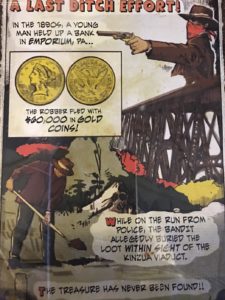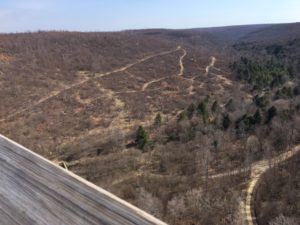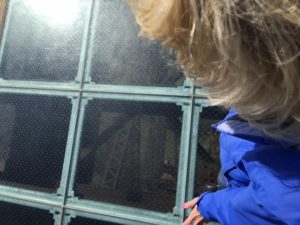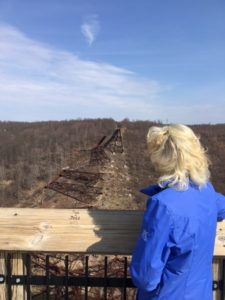
The Kinzua Bridge was once known as the ‘Eighth Wonder of the World’ and holds a possible key to finding a buried lost treasure. Located in Mckean county of Northern Pennsylvania, the Kinzua bridge was the longest and highest viaduct in the world when first built in 1882. It stood majestically, 301 feet high and spanned 2053 feet across the Kinzua Creek. It was considered an engineering masterpiece, and today offers a thrilling walk across the sky.
The Kinzua Bridge also offers the key to solving a mystery involving lost treasure. According to the story at the exhibition center of Kinzua State Park, in the late 1880’s, a bank in the nearby town of Emporium, Pa. was robbed. The young robber made away with over $60,000 in gold coins and fled into the surrounding mountains to escape capture by authorities.

Eventually, several days later, the robber was found, but in quite distress. He had traveled on foot through the dense woodlands without food or water and during cold rains. He was barely alive, with a high fever, but without the coins. Before passing away from sickness, he revealed he had buried the stolen loot beneath a triangular rock within site of the Kinzua Bridge.
Although many locals quickly searched the area, the hidden cache was never discovered. Today it is the lost treasure of the Kinzua Bridge. Metal detectorists and other treasure hunters continue to search the mountains where the Kinzua Viaduct lingers in site and beneath triangular rocks. The only two clues to where the lost treasure was buried.

Nonetheless, visiting the Kinzua skywalk and park is an adventure in itself. Although, the viaduct was used for many years to transport coal and other needed materials across the Kinzua gorge, it is now a tourist attraction. After a tornado raged through the gorge and brought down 11 of the 20 bridge’s base towers in July 2003, it was decided the remaining structure would be restored and turned into a pedestrian walkway.
The 11.000 square feet visitor’s center at Kinzua Bridge State Park consists now of two exhibit halls and highlights the history and building of the Bridge, and later the skywalk. Interactive displays showcase not only how the bridge was first built in only 94 days, without scaffolding, an amazing and daring feat for the time, but other interesting displays too. There is one where you get to hear the different sounds animals of the area make. Bobcats sound creepy.

And for those daring today, the skywalk features a partial glass-bottomed observation deck. One can stand on the glass and look down to the base of the towers. Thrilling. Visitors can also hike down to the bases and look up. I read the sign for how thick the glass was AFTER standing on it. It is only 1 inch! What?! I thought it would be thicker.
It was a pleasure to visit the Kinzua bridge and it truly is an excellent visitor’s center and piece of history hidden out in the middle of nowhere. There are other interesting places nearby as well, like the Ice Mine in Coudersport (with a treasure story itself) and Cherry Springs State Park which is known as having one of the ‘darkest skies on the East Coast’. It is a favorite spot for stargazers, and as you can guess, lights are strictly prohibited.

Although I didn’t end up finding the stolen loot during my visit at Kinzua Bridge this time (I’ll be going back), I found a different kind of lost treasure in the history of the area. Lost treasures can be found anywhere if you are looking for them!
Best of luck with all that you seek! Always Treasure the Adventure!
.
.


Hmmm, 60,000 gold coins, converting troy ounce to ounces, and even if each coin was only 1/10 of a troy ounce, that load weighs more than 400 pounds.
So I’m guessing that they were the 1/20 ounce gold dollar coin that was about half the size of a dime. That’s still 200 pounds.
I think the robber had help.
60,000 dollars in gold coins.
which is roughly 90 lbs at face value.
Yes, I’m sorry….let me edit 60,000 gold coins….TO $60,000 IN gold coins…what a difference an ‘$’ and an ‘in’ can do….
Thank you ~jenny
Still, $60,000 in the nineteenth century is quite a haul. Thanks for this story, I’d never heard of it before! So much to learn!!!
I’ll say.
Here’s a chart that shows gold value in the 1880’s at $20.67 per troy ounce.
http://onlygold.com/Info/Historical-Gold-Prices.asp
Gold was worth a little over $1,280.00 an ounce at yesterday’s close.
That’s almost 62 times more in value.
$60,000.00 x 62 = $3,720,000.00.
Depending on what coins they were, the value would be considerably higher than that.
By the way, at $20.67 a troy ounce and for $60,000, that’s just over 2,900 ounces (troy). Divide that by 12 to get 242 troy pounds. Add 10% to get a regular pound weight of around 266 pounds.
That’s a lot of gold.
Lets call it 10 “Fenn Indulgences”. lol
…because of the 20 pounds of gold in the chest.
(Thought I should say that.)
Some history, and danger, of the bridge.
http://www.treasurenet.com/forums/treasure-legends-pennsylvania/12651-kinzua-bridge-cache-pennsylvania.html
That story paints a different picture than Jenny’s source.
These kinds of things, how stories are related, cause confusion and are common in these lost treasure stories, it seems to me.
Lets consider that $60,000 figure now. Was that calculated based on values then or later on when gold went up in value? That could change the picture again, to a weight that’s a lot less.
And that could change the possibilities of what happened after the robber got away with the gold.
I’m also wondering, if this robber gets outside and starts putting heavy loads of gold on his horse, isn’t that an opportunity for the other men to take shots at him?
Speaking of shots, wouldn’t there have been an armed escort with that coach driver?
It’s questions like this that lead me to think there was more behind this story, and the guy had help.
Another thing. If this was payroll, it’s even more likely that the gold coins would be the 1/20th ounce “dollars”.
From what I’ve read about those coins, they functioned like the silver dollar. And in those times, they were worth $1.00.
This is supported by the gold value per ounce, $20.67 per troy ounce divided by 20 = $1.03 gold value per coin, in those days.
But here’s the thing. Those coins were discontinued in 1889 (I think I remember correctly).
Look at the timing.
Look at the strangeness of the case details.
Where’s that armed escort, or any defense at all?
What I’m getting at is that these coins, being soon to become collector’s items, but such a thing likely only known by people in high positions, well doesn’t that smack of a much larger plan by much higher people?
That doesn’t mean that the gold isn’t out there somewhere, lost and waiting. But it does make me wonder. What did the robber actually do after making his getaway? What would some very smart people in high positions have planned? What happened to the robber’s horse and how did he get left in such dire straits?
Was there a planned meetup that went wrong?
242… nice one, BuckeyeBob.
Jenny, thanks much for this article. Fascinating. This is an area that is close enough for me to visit, and the bridge is so cool.
Wonder how many searched for the cache, and how far away from the bridge?
Some background reading includes that the robber indicated the treasure was buried in glass jars.
I don’t get this part. If he’s fleeing through the dense woods, where is he going to find glass jars to put the coins in?
Does anyone know more about this?
Hello astree. I appreciate the link you provided above. My thoughts after reading it, and the question you’ve asked, makes me think there may have been a possibility that the robbery was premeditated, and the bottles may have been placed there beforehand. Another thought, although not knowing the area, perhaps he wandered the woods and came upon a root cellar with jars. This is an opinion, offered as a thought.
There’s always a good case of delirium.
I think a robbery of this nature would have a plan in place.
Carrying around a large stash of gold definitely isn’t advisable.
Glass jars would probably be the best choice between ease of burying and cost. Burying a barrel would be a lot harder, and the cost of a chest might have been out of this guy’s reach before hand.
Thank you for this interesting story, Jenny.
Hi Jenny!!
Not all of it was in gold coin, some of it was paper money, maybe most of it. I have an idea where it is buried. Do you have a snail mail address that I could send you a maps and info. If you are interested that is. It’s about 4,000 feet from the bridge.
Sam Peppiatt
Hi Sam, I do plan on going back, so would love to scout around your area for you. You can contact me at jennykile @ outlook . com.
I’d like your map info to compare with mine please
Follow up,
“astree” don’t you suppose he knew it was currency, so he brought the jars with him to protect the money from the elements, if and when he buried it. If you are close by, there is a big rock one mile South of the bridge and a little bit East. I don’t know if it is triangle shape but there is a road that goes straight to it. It’s high ground so I expect you could see the bridge from there.
I know, you can lead a man to treasure but you can’t get him to dig———-Sam Peppiatt
To all,
This area is state game land. What I thought was a rock could actually be a blind of some kind for hunting deer. Just can’t be sure, and there looks to be a gate across the road. Maybe you should forget it. Sam
What an idiot I am. What I thought was a rock or rocks is actually an oil, or gas well. State game land no. 62 is a little farther East. There road leads to the head of a deep canyon. The rock where the money is buried could be down in this canyon. They, state game land No. 62, have an office in Mt. Jewett, and apparently allow visitors other than hunters. If the rock is down in the canyon, there is a good chance of finding it. The idea is; he couldn’t see the bridge until he got up onto high ground. For what ever it’s worth, Sam